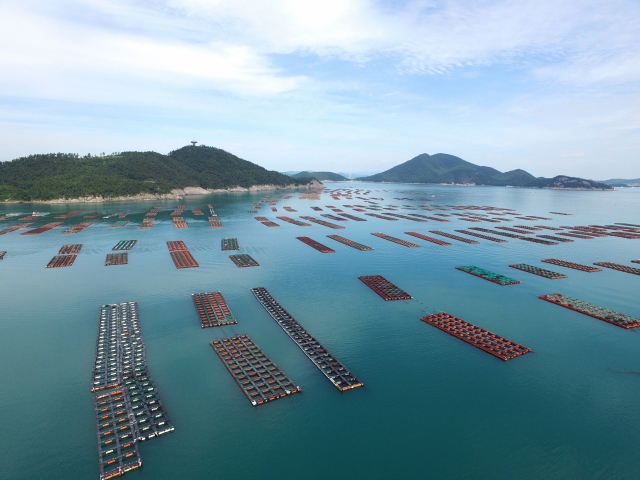 |
Shown in this undated file photo provided by the county of Wando is an abalone farm in the region. (Wando County, South Jeolla Province) |
For a long time, the ocean functioned as a set of passageways for ships and a space to catch fish. However, today’s ocean offers us much more. Some may enjoy the sea as a leisure venue for surfing as they ride across the cool waves, and others may think of it as a place with a marine science base that continues to respond to climate change. The sea also serves as a repository for renewable energy, including tidal, wave and wind power. Ninety-nine percent of the world’s internet traffic passes through undersea sea routes via submarine cables.
In the past, the use of marine space was limited to a handful of selected purposes – such as fisheries, military activities and vessel operations -- that prevented most conflicts between different stakeholders. However, the gradual diversification and scaled-up use and development of the oceans in recent years has also triggered an increase in conflicts among different users. Moreover, there are a growing number of serious challenges from indiscriminate marine developments that may irrecoverably disrupt and destroy the marine environment and its associated resources.
Against this backdrop, the Ministry of Oceans and Fisheries announced its plans to enhance the orderly use of marine spaces on Oct. 5 with the aim to establish a rational spatial management system that takes into account the characteristics of Korean waters, under the vision of “a free and safe ocean for the people, with orderly utilization,” in line with changes surrounding the use and development of the oceans.
The upcoming improvement plan mainly enhances responsibilities in marine space usage and associated management to promote a sustainable marine usage environment. This can help prevent unplanned development in advance and further categorization of marine use zones to rationalize the use of marine space. In addition, the plan will support enjoyable marine leisure activities for the public to respond to the new demand for marine usage and accelerate the development of regionally driven for-profit business models to promote the economic revitalization of maritime communities.
The previous marine usage zone framework only classified marine spaces into 9 areas, including fisheries, environment and energy. These were solely based on surface dimensions. Moreover, there were no regulations on locations where there were overlapping multiple activities, resulting in frequent conflicts between users. The new improvement plan further categorizes use zones and considers the vertical dimensions of the sea surface, mid-sea, and the sea floor, in addition to the horizontal dimensions, to better manage the location adequacy for development activities. For example, fishing zones will be classified into levels 1 through 5, depending on their activity density, which will become the basis for determining the level of tolerance for other activities, such as marine leisure or granting business permissions for offshore wind power generation. Moreover, the responsibility of restoring marine space following its use will be enhanced while creating a new national supervisory authority to oversee any illegal use to ensure effective spatial management, with the aim of creating a sustainable marine use environment.
 |
Song Sang-keun (Ministry of Oceans and Fisheries) |
The demand for new marine leisure activities will be met more proactively. While there is increased visitor traffic to coastal regions following the recent popularity of camping at beach sites or increased sea fishing trips, dissatisfaction and complaints from local residents are also increasing due to coastal environment pollution and trash dumping. Therefore, regulations on the construction of convenience facilities or buildings that meet the new travel demand will be relaxed, while developing travel profit models that are to be mainly managed by local communities, to embed a mutually beneficial marine leisure culture.
Another challenge for Korean oceans is that there are no boundaries that separate the different regions. Therefore, any disputes between local governments regarding management of licenses or permits can only be resolved by the ruling of the Constitutional Court on power disputes. However, these means of conflict resolution lead to the unnecessary waste of administrative capacity and a lot of time, eventually resulting in inconvenience to the public. For example, the 2011 dispute over fishing area incursions regarding the anchovy farm between Namhae, South Gyeongsang Province, and Yeosu, South Jeolla Province continued for 10 years until a the dispute was resolved by the Constitutional Court. The Ministry of Oceans and Fisheries plans to enact a law to determine maritime boundaries that can help resolve potential conflicts arising from unclear ocean boundaries and to promote efficient use of the space.
Publicly shared natural resources such as sea routes, marine resources and fish farms do not belong to any one person or entity. Thus, a systematic and scientific spatial management plan is necessary as a growing number of people make use of the ocean. We ask our fellow Koreans for their encouragement and support regarding the new improvement plan to ensure rational utilization of our waters, which are owned by all Koreans. We also hope to hand down a healthy and whole ocean space to future generations.
By Song Sang-keun
Song Sang-keun is the vice minister of oceans and fisheries at the Ministry of Oceans and Fisheries. -- Ed.By Korea Herald (
khnews@heraldcorp.com)





![[Herald Interview] 'Trump will use tariffs as first line of defense for American manufacturing'](http://res.heraldm.com/phpwas/restmb_idxmake.php?idx=644&simg=/content/image/2024/11/26/20241126050017_0.jpg)

![[Health and care] Getting cancer young: Why cancer isn’t just an older person’s battle](http://res.heraldm.com/phpwas/restmb_idxmake.php?idx=644&simg=/content/image/2024/11/26/20241126050043_0.jpg)

